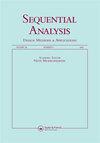Sequential Detection of an Arbitrary Transient Change Profile by the FMA Test
IF 0.6
4区 数学
Q4 STATISTICS & PROBABILITY
Sequential Analysis-Design Methods and Applications
Pub Date : 2023-03-21
DOI:10.1080/07474946.2023.2171056
引用次数: 2
Abstract
Abstract This article addresses the sequential detection of transient changes by using the finite moving average (FMA) test. It is assumed that a change occurs at an unknown (but nonrandom) change point and the duration of postchange period is finite and known. We relax the assumption that the profile of a transient change is chosen so that the log-likelihood ratios of the observations are associated random variables (r.v.s) in the prechange mode. Hence, the profile of the transient change is arbitrary and it is not necessarily of constant sign for a distribution with monotone likelihood ratio. A new upper bound for the worst-case probability of false alarm is proposed. It is shown that the optimization of the window-limited cumulative sum (CUSUM) test again leads to the FMA test. Three particular transient changes are considered: in the Gaussian mean, in the Gaussian variance, and in the parameter of exponential distribution. In the first case, a comparison between the bounds for the FMA test operating characteristics and the exact operating characteristics calculated by numerical integration is used to estimate the sharpness of the bounds. In the second and third cases, special attention is paid to the calculation of the FMA distribution in the case of arbitrary profile. The method of convolution is used to solve the problem.用FMA试验顺序检测任意瞬态变化剖面
摘要本文介绍了使用有限移动平均(FMA)测试对瞬态变化进行顺序检测的方法。假设变化发生在未知(但非随机)的变化点,并且变化后周期的持续时间是有限和已知的。我们放宽了这样的假设,即选择瞬态变化的轮廓,使得观测的对数似然比是预变化模式中的相关随机变量(r.v.s)。因此,瞬态变化的轮廓是任意的,对于具有单调似然比的分布来说,它不一定是常数符号。提出了一个新的虚警最坏情况概率的上界。结果表明,窗限累积和(CUSUM)检验的优化再次导致了FMA检验。考虑了三种特殊的瞬态变化:高斯均值、高斯方差和指数分布参数。在第一种情况下,FMA测试操作特性的边界与通过数值积分计算的精确操作特性之间的比较用于估计边界的锐度。在第二种和第三种情况下,特别注意任意剖面情况下FMA分布的计算。使用卷积的方法来解决这个问题。
本文章由计算机程序翻译,如有差异,请以英文原文为准。
求助全文
约1分钟内获得全文
求助全文
来源期刊

Sequential Analysis-Design Methods and Applications
STATISTICS & PROBABILITY-
CiteScore
1.40
自引率
12.50%
发文量
20
期刊介绍:
The purpose of Sequential Analysis is to contribute to theoretical and applied aspects of sequential methodologies in all areas of statistical science. Published papers highlight the development of new and important sequential approaches.
Interdisciplinary articles that emphasize the methodology of practical value to applied researchers and statistical consultants are highly encouraged. Papers that cover contemporary areas of applications including animal abundance, bioequivalence, communication science, computer simulations, data mining, directional data, disease mapping, environmental sampling, genome, imaging, microarrays, networking, parallel processing, pest management, sonar detection, spatial statistics, tracking, and engineering are deemed especially important. Of particular value are expository review articles that critically synthesize broad-based statistical issues. Papers on case-studies are also considered. All papers are refereed.
 求助内容:
求助内容: 应助结果提醒方式:
应助结果提醒方式:


